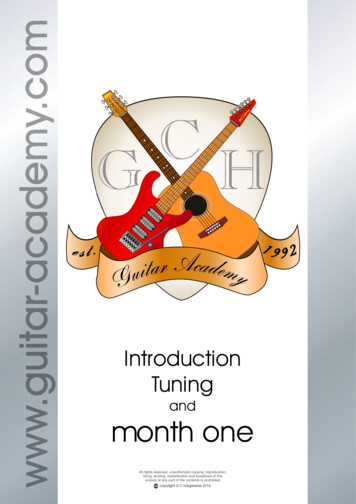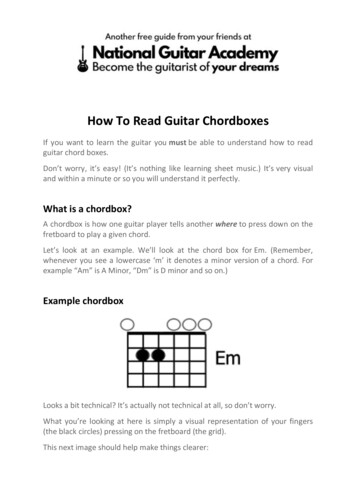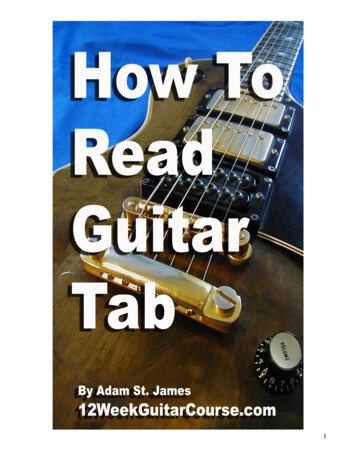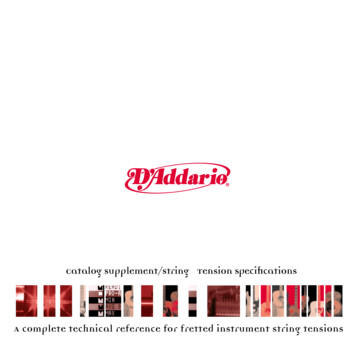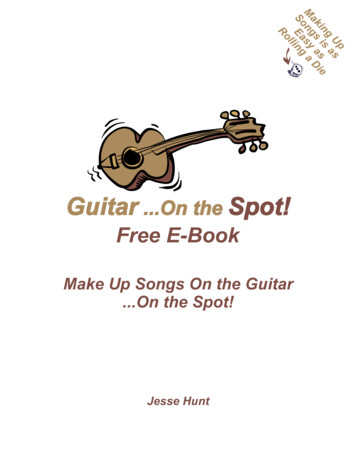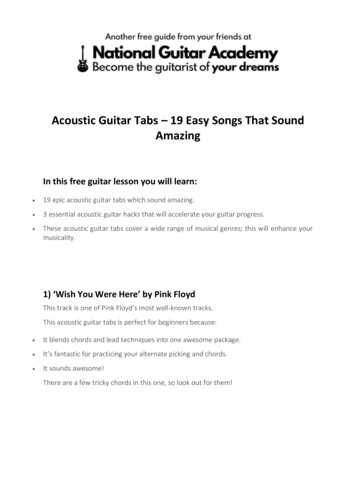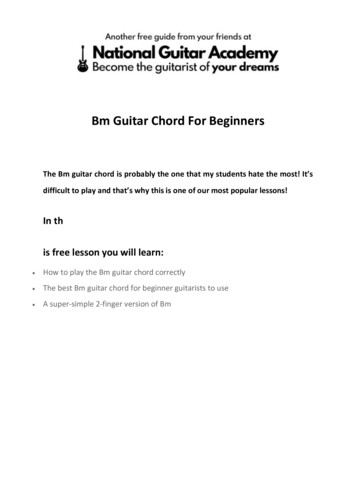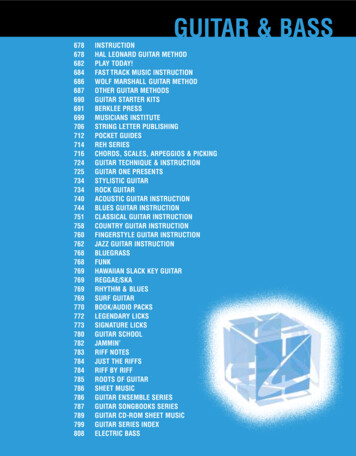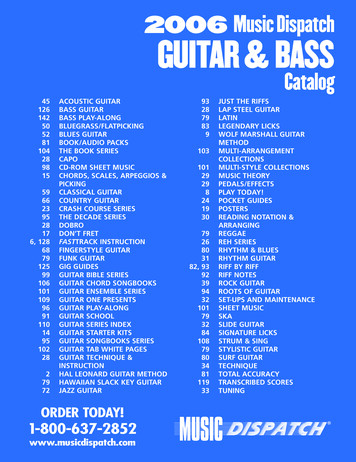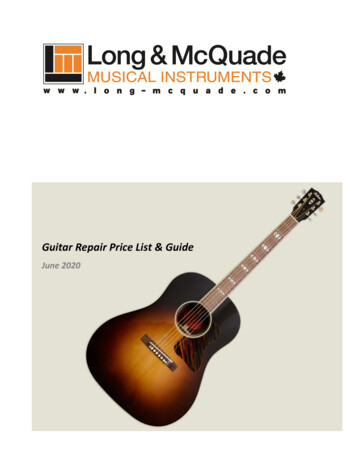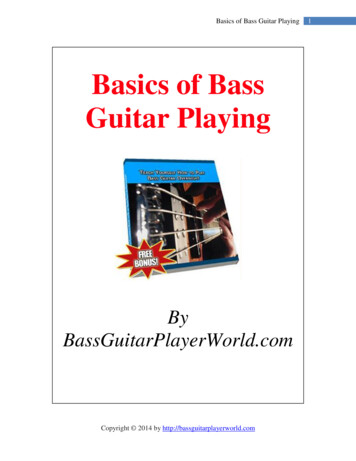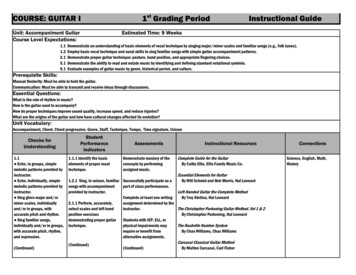
Transcription
COURSE: GUITAR IUnit: Accompaniment GuitarCourse Level Expectations:1.11.22.15.19.11st Grading PeriodInstructional GuideEstimated Time: 9 WeeksDemonstrate an understanding of basic elements of vocal technique by singing major/minor scales and familiar songs (e.g., folk tunes).Employ basic vocal technique and aural skills to sing familiar songs with simple guitar accompaniment patterns.Demonstrate proper guitar technique: posture, hand position, and appropriate fingering choices.Demonstrate the ability to read and notate music by identifying and defining standard notational symbols.Evaluate examples of guitar music by genre, historical period, and culture.Prerequisite Skills:Manual Dexterity: Must be able to hold the guitar.Communication: Must be able to transmit and receive ideas through discussions.Essential Questions:What is the role of rhythm in music?How is the guitar used to accompany?How do proper techniques improve sound quality, increase speed, and reduce injuries?What are the origins of the guitar and how have cultural changes affected its evolution?Unit Vocabulary:Accompaniment, Chord, Chord progression, Genre, Staff, Technique, Tempo, Time signature, UnisonChecks forUnderstanding1.1 Echo, in groups, simplemelodic patterns provided byinstructor. Echo, individually, simplemelodic patterns provided byinstructor. Sing given major and/orminor scales, individuallyand/or in groups, withaccurate pitch and rhythm. Sing familiar songs,individually and/or in groups,with accurate pitch, rhythm,and 1.1.1 Identify the basicelements of proper vocaltechnique.AssessmentsDemonstrate mastery of theconcepts by performingassigned music.Instructional ResourcesComplete Guide for the GuitarBy Cathy Ellis, Ellis Family Music Co.Essential Elements for Guitar1.2.1 Sing, in unison, familiar Successfully participate as aBy Will Schmid and Bob Morris, Hal Leonardpart of class performances.songs with accompanimentprovided by instructor.Left-Handed Guitar the Complete MethodComplete at least one writingBy Troy Stetina, Hal Leonard2.1.1 Perform, accurately,assignment determined by theselect scales and left handinstructor.The Christopher Parkening Guitar Method, Vol 1 & 2position exercisesBy Christopher Parkening, Hal LeonardStudents with IEP, ELL, ordemonstrating proper guitarphysical impairments maytechnique.The Nashville Number Systemrequire or benefit fromBy Chas Williams, Chas Williamsalternative assignments.(Continued)Carcassi Classical Guitar Method(Continued)By Matteo Carcassi, Carl FisherConnectionsScience, English, Math,History
Checks for UnderstandingContinued1.2 Sing familiar songs,individually and/or in groups,with accurate pitch, rhythm,and expression withaccompaniment provided bythe instructor. Sing familiar songs,individually and/or in groups,with accurate pitch, rhythm,and expression whileperforming simpleaccompaniment on guitar.2.1 Demonstrate appropriateplaying position: posture,holding instrument, left andright hand position. Perform given solo guitarpieces with correct classicalguitar technique (e.g.,Carcassi Guitar Method). Perform given ensembleguitar pieces with correctguitar technique appropriateto style of piece.5.1 Read and notate treble clef,bass clef, simple rhythmicpatterns, and simple musicalterms.(Continued)Student PerformanceIndicators ContinuedAssessments ContinuedQ2 semester exam & Q4 final5.1.1 Demonstrate theexamability to read and notatetreble clef, bass clef, simplerhythmic patterns, and simplemusical terms.Instructional Resources ContinuedA Modern Method for GuitarBy William Leavitt, Berklee PressClassical Guitar with Tablature, Book 1 & 2By Ben Bolt, Cherry Lane MusicEtudes Mecaniques: 12 Easy–Intermediate Studies for Guitar9.1.1 Listen to and identify thestyle and genre of simpleguitar compositions.By Stanley Yates, Mel BayHal Leonard Guitar Method, Book 1 & 2By Will Schmid and Greg Koch, Hal LeonardHow to Read Braille MusicBy Bettye Krolick, Opus comwww.finalemusic.comwww.grooveshark.com
5.1 Checks for Understanding Continued Read and notate key signatures, ledger lines, complex rhythmic patterns, and common symbols. Read chord progressions in individual performance. Demonstrate the ability to read chord progressions on guitar in individual or group performance, including twelve-bar blues progressions.9.1 Identify distinguishing characteristics of a given music genre, including instrumentation and style. Identify distinguishing characteristics of a given historical period, including significant composers and exemplary works, as they pertain to guitar. Analyze and describe a selected guitar selection from a given historical period. Analyze and describe a selected guitar selection from a given culture. Discuss the cultural and economic impact of a given historical event upon musicians and ensembles throughout Western history (i.e., American big bands becoming quartets and quintets inmid-twentieth century). Identify various ways in which culture influences music. Identify a specific culture and its representative music.
COURSE: GUITAR IUnit: Melodic GuitarCourse Level Expectations:1.11.22.12.35.19.12nd Grading PeriodInstructional GuideEstimated Time: 9 WeeksDemonstrate an understanding of basic elements of vocal technique by singing major/minor scales and familiar songs (e.g., folk tunes).Employ basic vocal technique and aural skills to sing familiar songs with simple guitar accompaniment patterns.Demonstrate proper guitar technique: posture, hand position, and appropriate fingering choices.Demonstrate well-developed ensemble skills through performance in large and small ensembles.Demonstrate the ability to read and notate music by identifying and defining standard notational symbols.Evaluate examples of guitar music by genre, historical period, and culture.Prerequisite Skills:Manual Dexterity: Must be able to hold the guitar.Communication: Must be able to transmit and receive ideas through discussions.Essential Questions:How do chord selections affect the mood of a piece?How does reading music affect one's ability to communicate with other musicians?What are the elements of a successful performance?How are intervals used as melodic building blocks?Unit Vocabulary:Articulation, Basic harmonic accompaniment, Body percussion, Dynamic levels, Dynamics, Elements of music, Ensemble, Event, Expression, Expressive, Interval, Meter, Scale, Simple meter,Standard notation, Symbols of musical expression, Technical accuracy, Technical skillsChecks forUnderstanding1.1 Echo, in groups, simplemelodic patterns provided byinstructor. Echo, individually, simplemelodic patterns provided byinstructor. Sing given major and/orminor scales, individuallyand/or in groups, withaccurate pitch and rhythm. Sing familiar songs,individually and/or in groups,with accurate pitch, rhythm,and expression.StudentPerformanceIndicators1.1.1 Identify the basicelements of proper vocaltechnique.AssessmentsDemonstrate mastery of theconcepts by performingassigned music.Instructional ResourcesComplete Guide for the GuitarBy Cathy Ellis, Ellis Family Music Co.Essential Elements for Guitar1.2.1 Sing, in unison, familiar Successfully participate as aBy Will Schmid and Bob Morris, Hal Leonardsongs with accompanimentpart of class performances.Left-Handed Guitar the Complete Methodprovided by instructor.By Troy Stetina, Hal LeonardComplete at least one writing2.1.1 Perform, accurately,assignment determined by theThe Christopher Parkening Guitar Method, Vol 1 & 2select scales and left handInstructor.position exercisesBy Christopher Parkening, Hal Leonarddemonstrating proper guitarStudents with IEP, ELL, orThe Nashville Number Systemtechnique.physical impairments mayBy Chas Williams, Chas Williamsrequire or benefit from(Continued)alternative assignments.ConnectionsScience, English, Math,History
Checks for UnderstandingContinuedStudent PerformanceIndicators1.2 Sing familiar songs,individually and/or in groups,with accurate pitch, rhythm,and expression withaccompaniment provided bythe instructor. Sing familiar songs,individually and/or in groups,with accurate pitch, rhythm,and expression whileperforming simpleaccompaniment on guitar.2.3.1 Perform, accurately,ensemble pieces at difficultylevel of 1-2.2.1 Demonstrate appropriateplaying position: posture,holding instrument, left andright hand position. Perform given solo guitarpieces with correct classicalguitar technique (e.g.,Carcassi Guitar Method). Perform given ensembleguitar pieces with correctguitar technique appropriateto style of piece.2.3Perform, accurately, givenguitar ensemble pieces withexpression and correctclassical guitar technique atappropriate level asdetermined by the instructor.(Continued)Assessments ContinuedInstructional Resources ContinuedQ2 semester exam & Q4 finalexamCarcassi Classical Guitar MethodBy Matteo Carcassi, Carl FisherA Modern Method for GuitarBy William Leavitt, Berklee Press5.1.1 Demonstrate theability to read and notatetreble clef, bass clef, simplerhythmic patterns, and simplemusical terms.Classical Guitar with Tablature, Book 1 & 2By Ben Bolt, Cherry Lane MusicEtudes Mecaniques: 12 Easy–Intermediate Studies for GuitarBy Stanley Yates, Mel Bay9.1.1 Listen to and identify thestyle and genre of simpleguitar compositions.Hal Leonard Guitar Method, Book 1 & 2By Will Schmid and Greg Koch, Hal LeonardHow to Read Braille MusicBy Bettye Krolick, Opus comwww.finalemusic.comwww.grooveshark.com
Checks for Understanding Continued5.1 Read and notate treble clef, bass clef, simple rhythmic patterns, and simple musical terms. Read and notate key signatures, ledger lines, complex rhythmic patterns, and common symbols. Read chord progressions in individual performance. Demonstrate the ability to read chord progressions on guitar in individual or group performance, including twelve-bar blues progressions.9.1 Identify distinguishing characteristics of a given music genre, including instrumentation and style. Identify distinguishing characteristics of a given historical period, including significant composers and exemplary works, as they pertain to guitar. Analyze and describe a selected guitar selection from a given historical period. Analyze and describe a selected guitar selection from a given culture. Discuss the cultural and economic impact of a given historical event upon musicians and ensembles throughout Western history (i.e., American big bands becoming quartets and quintets inmid-twentieth century). Identify various ways in which culture influences music. Identify a specific culture and its representative music.
3rd Grading PeriodCOURSE: GUITAR IUnit: Classical GuitarCourse Level Expectations:Instructional GuideEstimated Time: 9 Weeks2.1 Demonstrate proper guitar technique: posture, hand position, and appropriate fingering choices.5.1 Demonstrate the ability to read and notate music by identifying and defining standard notational symbols.6.1 Listen to and analyze a varied repertoire of Renaissance, Baroque, Classical, and Contemporary guitar music, describing the specific musicalcharacteristics of each period and genre.8.1 Compare and contrast how guitar music relates to other disciplines within the arts.8.2 Evaluate how guitar music and other disciplines outside of the arts are related.9.1 Evaluate examples of guitar music by genre, historical period, and culture.Prerequisite Skills:Manual Dexterity: Must be able to hold the guitar.Communication: Must be able to transmit and receive ideas through discussions.Essential Questions:What is the role of the right hand in classical guitar?What is the relationship between arpeggios and chords?What is the relationship between singing and playing?How does active listening improve appreciation and performance?Unit Vocabulary:Arpeggio, Common practice period, Genre, Musical periods, Timbre, ToneChecks forUnderstanding2.1 Demonstrate appropriateplaying position: posture,holding instrument, left andright hand position. Perform given solo guitarpieces with correct classicalguitar technique (e.g.,Carcassi Guitar Method). Perform given ensembleguitar pieces with correctguitar technique appropriateto style of piece.(Continued)StudentPerformanceIndicators2.1.1 Perform, accurately,select scales and left handposition exercisesdemonstrating proper guitarTechnique.AssessmentsDemonstrate mastery of theconcepts by performingassigned music.Instructional ResourcesComplete Guide for the GuitarBy Cathy Ellis, Ellis Family Music Co.Essential Elements for GuitarSuccessfully participate as apart of class performances.By Will Schmid and Bob Morris, Hal LeonardLeft-Handed Guitar the Complete Method5.1.1 Demonstrate theability to read and notateComplete at least one writingBy Troy Stetina, Hal Leonardtreble clef, bass clef, simpleassignment determined by theThe Christopher Parkening Guitar Method, Vol 1 & 2rhythmic patterns, and simple instructor.By Christopher Parkening, Hal Leonardmusical terms.Students with IEP, ELL, or6.1.1 Identify various musical physical impairments mayThe Nashville Number Systemgenres and name specificrequire or benefit fromBy Chas Williams, Chas Williamscharacteristics of each genre. alternative assignments.ConnectionsScience, English, Math,History
Checks for UnderstandingContinuedStudent PerformanceIndicators Continued5.1 Read and notate treble clef,bass clef, simple rhythmicpatterns, and simple musicalterms. Read and notate keysignatures, ledger lines,complex rhythmic patterns,and common symbols. Read chord progressions inindividual performance. Demonstrate the ability toread chord progressions onguitar in individual or groupperformance. Twelve-bar bluesprogression.8.1.1 Compare and contrasthow guitar music relates toother disciplines within thearts.6.1 Describe, verbally, the formheard in given listeningexamples of Renaissance,Baroque, Classical, Romanticand/or contemporary guitarmusic. Describe, verbally, the styleheard in given listeningexamples of Renaissance,Baroque, Classical, Romanticand/or contemporary guitarmusic. Describe, verbally, specificmusical elements heard ingiven listening examples ofRenaissance, Baroque,Classical, Romantic and/orcontemporary guitar music.(Continued)Assessments ContinuedInstructional Resources ContinuedQ2 semester exam & Q4 finalexamCarcassi Classical Guitar MethodBy Matteo Carcassi, Carl FisherA Modern Method for GuitarBy William Leavitt, Berklee Press8.2.1 Evaluate therelationship between guitarmusic and significantcontributions in academicdisciplines outside the arts.Classical Guitar with Tablature, Book 1 & 29.1.1 Listen to and identify thestyle and genre of simpleguitar compositions.Hal Leonard Guitar Method, Book 1 & 2By Ben Bolt, Cherry Lane MusicEtudes Mecaniques: 12 Easy–Intermediate Studies for GuitarBy Stanley Yates, Mel BayBy Will Schmid and Greg Koch, Hal LeonardHow to Read Braille MusicBy Bettye Krolick, Opus comwww.finalemusic.comwww.grooveshark.com
6.1 Checks for Understanding ContinuedDescribe, verbally, compositional characteristics of the composers of given listening examples from guitar music.Write an analysis of the form heard in given listening examples of Renaissance, Baroque, Classical, Romantic and/or contemporary guitar music.Write an analysis of the style heard in given listening examples of Renaissance, Baroque, Classical, Romantic and/or contemporary guitar music.Write an analysis of specific musical elements heard in given listening examples of Renaissance, Baroque, Classical, Romantic and/or contemporary guitar music.Write an analysis of the compositional characteristics of the composers of given listening examples from guitar music.8.1 Provide a verbal and/or written assessment of how a guitar piece from a given musical period relates/connects to another discipline within the arts of that same historical period(e.g., Debussy’s Sunken Cathedr al , or any Debussy Prelude, and paintings by Monet).8.2 Provide a verbal and/or written assessment of how a guitar piece from a given musical period relates/connects to an academic discipline outside the arts of that same historical period (e.g.,Joplin’s Maple Leaf Rag, or any of Joplin’s ragtime music, and the American culture of the 1920’s).9.1 Identify distinguishing characteristics of a given music genre, including instrumentation and style. Identify distinguishing characteristics of a given historical period, including significant composers and exemplary works, as they pertain to guitar. Analyze and describe a selected guitar selection from a given historical period. Analyze and describe a selected guitar selection from a given culture. Discuss the cultural and economic impact of a given historical event upon musicians and ensembles throughout Western history (i.e., American big bands becoming quartets and quintets inmid-twentieth century). Identify various ways in which culture influences music. Identify a specific culture and its representative music.
4th Grading PeriodCOURSE: GUITAR IUnit: Creativity and Alternative NotationCourse Level Expectations:1.12.12.33.24.15.17.29.1Instructional GuideEstimated Time: 9 WeeksDemonstrate an understanding of basic elements of vocal technique by singing major/minor scales and familiar songs (e.g., folk tunes).Demonstrate proper guitar technique: posture, hand position, and appropriate fingering choices.Demonstrate well-developed ensemble skills through performance in large and small ensembles.Improvise rhythmic or melodic variations on a given melody.Compose guitar music within specified guidelines, using technology when available.Demonstrate the ability to read and notate music by identifying and defining standard notational symbols.Compare and contrast how guitar music relates to other disciplines within the arts.Evaluate examples of guitar music by genre, historical period, and culture.Prerequisite Skills:Manual Dexterity: Must be able to hold the guitar.Communication: Must be able to transmit and receive ideas through discussions.Essential Questions:What is the role of rhythm in improvisation?How has the blues influenced popular music?What are the strengths and weaknesses of each notational system?What is the relationship between improvisation and composing?What are the applications of your musical training?Unit Vocabulary:Arrange, Blues progression, Blues scale, Compose, Ensemble, Event, Expression, Expressive, Iconic notation, Improvise, Nonstandard notation, Pentatonic scale, Primary chords, Technicalaccuracy, Technical skillsChecks forUnderstanding1.1 Echo, in groups, simplemelodic patterns provided byinstructor. Echo, individually, simplemelodic patterns provided byinstructor. Sing given major and/orminor scales, individuallyand/or in groups, withaccurate pitch and 1 Identify the basicelements of proper vocaltechnique.Demonstrate mastery of theconcepts by performingassigned music.2.1.1 Perform, accurately,select scales and left handposition exercisesdemonstrating proper guitartechnique.Successfully participate as apart of class performances.Instructional ResourcesComplete Guide for the GuitarBy Cathy Ellis, Ellis Family Music Co.Essential Elements for Guitar(Continued)By Will Schmid and Bob Morris, Hal LeonardLeft-Handed Guitar the Complete MethodComplete at least one writingBy Troy Stetina, Hal Leonardassignment determined by theThe Christopher Parkening Guitar Method, Vol 1 & 2instructor.By Christopher Parkening, Hal Leonard(Continued)ConnectionsScience, English, Math,History
1.1 Checks for UnderstandingContinued Sing familiar songs,individually and/or in groups,with accurate pitch, rhythm,and expression.Student PerformanceIndicators Continued2.1 Demonstrate appropriateplaying position: posture,holding instrument, left andright hand position. Perform given solo guitarpieces with correct classicalguitar technique (e.g.,Carcassi Guitar Method). Perform given ensembleguitar pieces with correctguitar technique appropriateto style of piece.3.2.1 Improvise an eightQ2 semester exam & Q4 finalmeasure rhythmic andexammelodic variation over primarychord progression in the keysof C and G in 4/4 meter.2.3.1 Perform, accurately,ensemble pieces at difficultylevel of 1-2.Assessments ContinuedInstructional Resources ContinuedStudents with IEP, ELL, orphysical impairments mayrequire or benefit fromalternative assignments.The Nashville Number SystemBy Chas Williams, Chas WilliamsCarcassi Classical Guitar MethodBy Matteo Carcassi, Carl Fisher2.3 Perform, accurately, givenguitar ensemble pieces withexpression and correctclassical guitar technique atappropriate level asdetermined by the instructor.By William Leavitt, Berklee PressClassical Guitar with Tablature, Book 1 & 2By Ben Bolt, Cherry Lane Music4.1.1 Compose simple fourmeasure melodies, followingspecified guidelines, in selectmajor keys, in 4/4 meter.Etudes Mecaniques: 12 Easy–Intermediate Studies for GuitarBy Stanley Yates, Mel BayHal Leonard Guitar Method, Book 1 & 25.1.1 Demonstrate theability to read and notatetreble clef, bass clef, simplerhythmic patterns, and simplemusical terms.7.2.1 Evaluate guitarperformances (of others andpersonal) including a writtenassessment of how musicalelements were used to form3.2opinions about the Improvise an eight-measure performances.rhythmic and/or melodicvariation of a given melodic9.1.1 Listen to and identify thepattern.style and genre of simple Improvise a sixteenguitar compositions.measure rhythmic andmelodic variation of a givenmelodic pattern.(Continued)A Modern Method for GuitarBy Will Schmid and Greg Koch, Hal LeonardHow to Read Braille MusicBy Bettye Krolick, Opus comwww.finalemusic.comwww.grooveshark.com
3.2 Checks for Understanding Continued Improvise a rhythmic variation over simple chord progressions (e.g., employing the technique of anticipation and retardation).4.1 Compose a simple four-measure melody, following specific guidelines, in select major keys, in 4/4 meter. Compose a simple eight-measure melody, following specific guidelines, in select major keys, in 4/4 and/or 3/4 meter. Compose a simple eight-measure chord progression, in chord melody style, in select major keys, in 4/4 and/or 3/4 meter. Compose a blues guitar solo over a twelve-bar blues chord progression employing the blues scale beginning on the tonic of the key chosen.5.1 Read and notate treble clef, bass clef, simple rhythmic patterns, and simple musical terms. Read and notate key signatures, ledger lines, complex rhythmic patterns, and common symbols. Read chord progressions in individual performance. Demonstrate the ability to read chord progressions on guitar in individual or group performance. Twelve-bar blues progression.7.2 Evaluate a given guitar performance, identifying expressive elements that are employed by the performer (e.g., tempo, dynamics, phrasing). Provide a written assessment of how a given guitar performance uses musical elements such as dynamics, tempo and articulation to evoke feelings and emotions. Critique a video or sound recording of a personal performance and evaluate performance based on proper technique and musical elements. Critique a video or sound recording of a personal performance and evaluate performance in terms of aesthetic qualities. Compare the expressive quality and technique in a personal performance to an exemplary recorded performance of the same guitar piece.9.1 Identify distinguishing characteristics of a given music genre, including instrumentation and style. Identify distinguishing characteristics of a given historical period, including significant composers and exemplary works, as they pertain to guitar. Analyze and describe a selected guitar selection from a given historical period. Analyze and describe a selected guitar selection from a given culture. Discuss the cultural and economic impact of a given historical event upon musicians and ensembles throughout Western history (i.e., American big bands becoming quartets and quintets inmid-twentieth century). Identify various ways in which culture influences music. Identify a specific culture and its representative music.
COURSE: GUITAR IIUnit: Accompaniment GuitarCourse Level Expectations:1.11.22.15.19.11st Grading PeriodInstructional GuideEstimated Time: 9 WeeksDemonstrate an understanding of basic elements of vocal technique by singing major/minor scales and familiar songs (e.g., folk tunes).Employ basic vocal technique and aural skills to sing familiar songs with simple guitar accompaniment patterns.Demonstrate proper guitar technique: posture, hand position, and appropriate fingering choices.Demonstrate the ability to read and notate music by identifying and defining standard notational symbols.Evaluate examples of guitar music by genre, historical period, and culture.Prerequisite Skills:Successful completion of Guitar I (or the equivalent) and teacher audition.Communication: Must be able to transmit and receive ideas through discussions.Essential Questions:Who are the founding fathers of guitar? Bios/ BackgroundHow do proper techniques improve sound quality, increase speed, and reduce injuries?What is the role of rhythm in music?What are the identifying characteristics of accompaniment styles for various genres?Unit Vocabulary:Accompaniment, Chord, Chord progression, Genre, Staff, Technique, Tempo, Time signature, UnisonChecks forUnderstandingStudentPerformanceIndicators1.1 Echo, in groups, simplemelodic patterns provided byinstructor. Echo, individually, simplemelodic patterns provided byinstructor. Sing given major and/orminor scales, individuallyand/or in groups, withaccurate pitch and rhythm. Sing familiar songs,individually and/or in groups,with accurate pitch, rhythm,and expression.1.1.2 Demonstrate propervocal technique while singingin groups, in e mastery of theconcepts by performingassigned music.Instructional ResourcesComplete Guide for the GuitarBy Cathy Ellis, Ellis Family Music Co.Essential Elements for Guitar1.2.2 Sing, in harmony,familiar songs withaccompaniment provided byInstructor.2.1.2 Perform, accurately,select scales and arpeggiosin various rhythms, alone andin ensemble, demonstratingproper guitar technique.Successfully participate as apart of class performances.By Will Schmid and Bob Morris, Hal LeonardLeft-Handed Guitar the Complete MethodComplete at least one writingBy Troy Stetina, Hal Leonardassignment determined by theinstructor.The Christopher Parkening Guitar Method, Vol 1 & 2By Christopher Parkening, Hal LeonardStudents with IEP, ELL, orphysical impairments mayThe Nashville Number Systemrequire or benefit fromBy Chas Williams, Chas Williamsalternative assignments.Carcassi Classical Guitar Method(Continued)By Matteo Carcassi, Carl FisherConnectionsScience, English, Math,History
Checks for UnderstandingContinued1.2 Sing familiar songs,individually and/or in groups,with accurate pitch, rhythm,and expression withaccompaniment provided bythe instructor. Sing familiar songs,individually and/or in groups,with accurate pitch, rhythm,and expression whileperforming simpleaccompaniment on guitar.2.1 Demonstrate appropriateplaying position: posture,holding instrument, left andright hand position. Perform given solo guitarpieces with correct classicalguitar technique (e.g.,Carcassi Guitar Method). Perform given ensembleguitar pieces with correctguitar technique appropriateto style of piece.5.1 Read and notate treble clef,bass clef, simple rhythmicpatterns, and simple musicalterms.(Continued)Student PerformanceIndicators ContinuedAssessments ContinuedQ2 semester exam & Q4 final5.1.2 Demonstrate the ability examto read and notate keysignatures, ledger lines,complex rhythmic patterns,and common symbols.Instructional Resources ContinuedA Modern Method for GuitarBy William Leavitt, Berklee PressClassical Guitar with Tablature, Book 1 & 2By Ben Bolt, Cherry Lane MusicEtudes Mecaniques: 12 Easy–Intermediate Studies for Guitar9.1.2 Compare and contrastthe musical characteristics ofguitar compositions fromvarious cultures.By Stanley Yates, Mel BayHal Leonard Guitar Method, Book 1 & 2By Will Schmid and Greg Koch, Hal LeonardHow to Read Braille MusicBy Bettye Krolick, Opus comwww.finalemusic.comwww.grooveshark.com
5.1 Checks for Understanding Continued Read and notate key signatures, ledger lines, complex rhythmic patterns, and common symbols. Read chord progressions in individual performance. Demonstrate the ability to read chord progressions on guitar in individual or group performance, including twelve-bar blues progressions.9.1 Identify distinguishing characteristics of a given music genre, including instrumentation and style. Identify distinguishing characteristics of a given historical period, including significant composers and exemplary works, as they pertain to guitar. Analyze and describe a selected guitar selection from a given historical period. Analyze and describe a selected guitar selection from a given culture. Discuss the cultural and economic impact of a given historical event upon musicians and ensembles throughout Western history (i.e., American big bands becoming quartets and quintets inmid-twentieth century). Identify various ways in which culture influences music. Identify a specific culture and its representative music.
COURSE: GUITAR IIUnit: Melodic GuitarCourse Level Expectations:1.11.22.12.35.19.12nd Grading PeriodInstructional GuideEstimated Time: 9 WeeksDemonstrate an understanding of basic elements of vocal technique by singing major/minor scales and familiar songs (e.g., folk tunes).Employ basic vocal tech
The Christopher Parkening Guitar Method, Vol 1 & 2 By Christopher Parkening, Hal Leonard The Nashville Number System By Chas Williams, Chas Williams Science, English, Math, History. Checks for Understanding Continued 1
